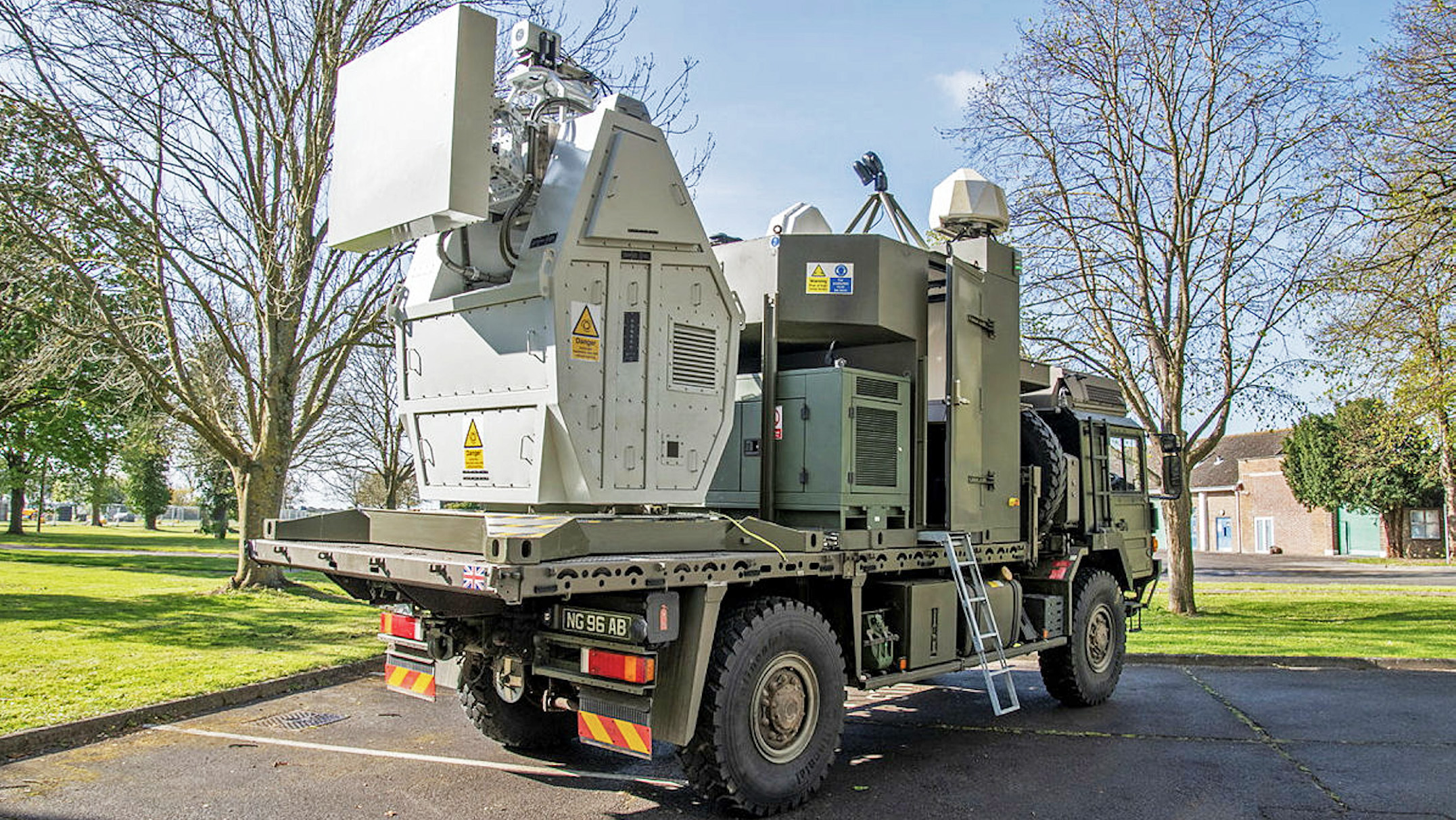The British Army has, for the first time, used a directed-energy weapon to bring down a swarm of drones during trials. The Radio Frequency Directed Energy Weapon demonstrator, or RF DEW, reflects a fast-growing trend to harness new ways of neutralizing the drone threat, both on the battlefield and for homeland defense.The U.
K. Ministry of Defense today announced the completion of the landmark trials, which took place at Air Defense Range Manorbier in West Wales. Operated by British Army soldiers, the RF DEW demonstrator, mounted on an RMMV HX60 4×4 truck chassis, was used to track, target, and defeat swarms of drones.

In total, the trials saw the weapon bring down more than 100 drones, with one experiment including two swarms of drones that were neutralized in a single engagement — the total number of drones involved in that particular test was not disclosed.As a directed-energy weapon, a broader category that also includes lasers, the RF DEW system tackles the target or targets without the use of a projectile. Instead, high-frequency radio waves disrupt or damage critical electronic components inside the drones, leading them to crash or malfunction.
The system is “capable of neutralizing multiple targets simultaneously with near-instant effect,” the U.K. Ministry of Defense said.
Highly automated, the RF DEW includes sensors for detection and tracking, as well as the weapon itself, in a single integrated system. The sensor suite includes a wide-area surveillance radar, also used for tracking and targeting, plus an optical camera that the operator can use to identify particular targets.Multiple drones are seen through the optics of an RF DEW system operator.
Crown Copyright screencap The Ministry of Defense added that RF DEW systems of this type are able to defeat airborne drones at ranges of up to one kilometer (0.6 miles) and are effective against threats that cannot otherwise be jammed using electronic warfare. The ministry added that the cost ‘per shot’ for the RF DEW is around 10 pence or around 13 U.
S. cents.The effector part of the RF DEW system which generates an intense beam of radio-frequency energy.
Crown Copyright “RF DEW is an exciting concept, explained Sgt. Mayers, a Senior Remotely Piloted Air Systems Operator from the British Army’s 106 Regiment Royal Artillery. “We found the demonstrator quick to learn and easy to use.
With improvements on range and power, which could come with further development, this would be a great asset to layered air defense.”Sgt. Mayers was described by the Ministry of Defense as the first British soldier to bring down drones using a radiofrequency weapon.
The RF DEW system was developed by an industry consortium led by Thales U.K., part of a U.
K. government investment of more than £40 million (around $53 million) in research and development in this area.Thales uses the commercial name RapidDestroyer for the RF DEW system used in the British Army trials.
The company offers the system as a standalone counter-drone solution. “part of a collective of effectors, or part of an integrated air defense configuration, such as ForceShield.” The ForceShield configuration includes radars, a control station, short-range surface-to-air missiles, and guns.
According to Thales, the RF DEW system is particularly relevant for tackling “swarms of incoming mini and micro drones, making it an excellent complementary system to existing, conventional short-range air defense systems such as the Lightweight Multi-role Missile (LMM).”The RF DEW project is managed by Team Hersa, a collaboration between Defense Equipment & Support, responsible for providing equipment and support services to the U.K.
Armed Forces, and the Defense Science and Technology Laboratory, which is the research and development branch of the Ministry of Defense.At this stage, the RF DEW system is not being procured for the U.K.
Armed Forces, although the Ministry of Defense notes that “it could provide a cost-effective complement to traditional missile-based air defense systems [...
] if developed into operational service.” Previous reports suggest that a production version of the system could be fielded as soon as 2027.Another view of the RF DEW system.
Crown Copyright Undoubtedly, fielding new equipment to better tackle the threat posed by drones, especially swarming ones, is a growing concern globally.“The development of RF DEW systems could help to protect the United Kingdom from unidentified drones at security-sensitive areas such as defense bases and could play a role in preventing disruption at airports,” said Maria Eagle, the Minister for Defense Procurement and Industry.Eagle’s words are especially relevant in light of the drone incursions over and near the U.
S. air base at RAF Lakenheath in England last November, which you can read about here.This was just one of many drone incursions recorded over a U.
S. military installation or sensitive area, a topic that TWZ has covered extensively.A satellite image of RAF Lakenheath.
Google Earth Her reference to “disruption at airports” likely points to incidents at the commercial Gatwick Airport in England. Back in 2018, a “sustained drone attack” saw the airport shut for more than 24 hours, and similar incidents have occurred at the same location since then.Meanwhile, the significant impact that drones can have on the battlefield has been well demonstrated in Ukraine, where both sides make extensive use of drones of different kinds, with first-person-view (FPV) types being the most prevalent.
According to the U.K. Ministry of Defense, Ukraine had to defend itself against attacks from more than 18,000 drones last year alone.
Outside of that conflict, drones have also made a significant mark in various crises in and around the Middle East.A Ukrainian soldier operates an FPV drone to observe Russian positions in the Kherson region of Ukraine. Photo by Oles Kromplias/Global Images Ukraine via Getty Images Global Images UkraineIn the context of U.
S. homeland defense, TWZ has looked in detail at the pros and cons of fielding radiofrequency directed-energy weapons, among other counter-drone solutions.Faced by confusing legal and regulatory hurdles, the U.
S. military has said it’s not currently interested in fielding kinetic and directed-energy capabilities, such as laser and high-power microwave weapons, let alone surface-to-air interceptors, or gun systems, for defending domestic bases and other critical infrastructure from drone threats. Instead, the U.
S. military’s focus is on electronic warfare and cyber warfare, and other ‘soft-kill’ options, at least for now.After all, as we discussed in the past, even lower tiers of counter-drone weapons, such as lasers and high-power microwave systems, can create dangerous or otherwise serious collateral effects.
While that might not be an issue on the battlefield, it certainly raises questions about their suitability for homeland defense. On the other hand, the words of the U.K.
government suggest that the RF DEW system is certainly being considered for such a role, although perhaps only in already highly restricted areas, like air bases and other larger installations. A radiofrequency directed-energy weapon also offers notable advantages over ‘soft-kill’ options, like electronic warfare jammers, in that it can also bring down drones that are operating autonomously by disrupting their onboard electronics.A close-up of the effector module of the RF DEW system, with the optical camera on top of it, used to identify particular targets.
Crown Copyright As we have discussed before — and will revisit again soon in an in-depth story — high-power microwave (HPM) directed-energy weapons are an area in which the U.S. military, including the Navy, is currently investing.
Among the leading players here is Epirus, whose Leonidas system has been integrated on the Stryker armored fighting vehicle. Other examples include the Tactical High-power Operational Responder, also known as THOR, a containerized counter-drone system that the U.S.
Air Force has been testing. Like the British system, THOR is designed to engage multiple drones at short ranges in a point defense role. It’s worth noting that another counter-drone solution appears to have been deployed by the British Army at RAF Lakenheath — and two other U.
S.-staffed bases — in response to the drone incursions there last year.“A military source .
.. confirmed that the RAF had offered the United States a counter-drone system that can electronically take command of an enemy drone and turn it back on itself to try to identify those flying the drones,” according to The Times newspaper in the United Kingdom.
The system described was NINJA, originally developed for the U.S. Air Force and subsequently becoming part of the Royal Air Force ORCUS system, which also includes a counter-drone electronic warfare jamming system called Guardian and various sensors.
A graphic showing elements of the RAF’s Orcus counter-drone suite. Crown Copyright Although it is unclear if this capability or others were actually deployed to those bases, it’s clear that counters to these kinds of drone threats are being taken increasingly seriously by the U.K.
Armed Forces.The British Army last October tested a high-energy laser, another type of directed-energy weapon, which was fired from a Wolfhound protected troop-carrying vehicle, at a range in Wales. Once again, these trials saw the weapon successfully destroy aerial drones.
A British Army Wolfhound fitted with a laser weapon — the High Energy Laser demonstrator. Crown Copyright Whatever the future of the RF DEW system and RapidDestroyer, it’s clear that the drone threat continues to proliferate globally among state and non-state actors, including organized criminal groups.When it comes to acquiring and operating drones — including armed ones — the barrier to entry is and has been low.
In the context of the United Kingdom, there have already been multiple incidents underscoring the reality of these kinds of threats. With that in mind, it’s no surprise that the British Army is looking closely at the RF DEW system for potential deployment domestically, as well as on the battlefield, especially as the threat of truly networked swarms looms ever closer.Contact the author: thomas@thewarzone.
comThe post British High-Power Microwave Weapon Successfully Tested Against Drone Swarms appeared first on The War Zone..
Technology

British High-Power Microwave Weapon Successfully Tested Against Drone Swarms

The post British High-Power Microwave Weapon Successfully Tested Against Drone Swarms appeared first on The War Zone.















